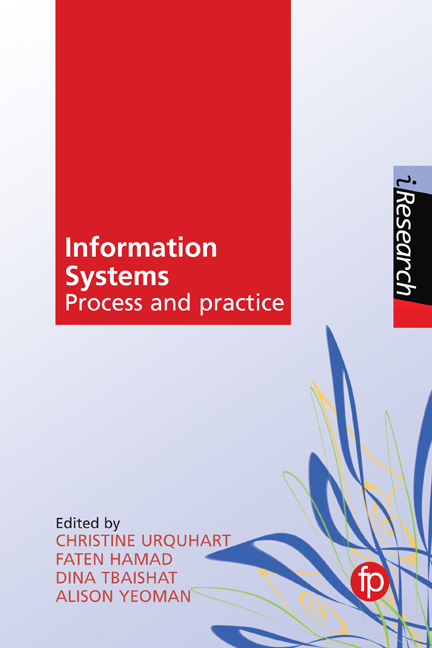Book contents
- Frontmatter
- Contents
- List of tables and figures
- Series editor's foreword
- About the authors
- 1 Introduction
- 2 Approaches to information architecture
- 3 Taxonomy testing for information architecture
- 4 The enterprise website and its information structures
- 5 Analysing activities, roles and processes
- 6 Libraries and the organisation of library processes – a history of operational research, and the use of process modelling
- 7 Using Riva process modelling to study book acquisition in academic libraries
- 8 Workflow analysis and process mapping in US academic libraries
- 9 A theoretical framework for designing and evaluating semi-structured document triage interfaces
- 10 Resource discovery case studies
- 11 Increasing social connection through a community-of-practice-inspired design
- 12 Methods for studying information provision, networking and communication in patient support groups
- 13 Health information systems: clinical data capture and document architecture
- 14 Producing systematic reviews and getting evidence to the clinician
- Index
14 - Producing systematic reviews and getting evidence to the clinician
Published online by Cambridge University Press: 08 June 2018
- Frontmatter
- Contents
- List of tables and figures
- Series editor's foreword
- About the authors
- 1 Introduction
- 2 Approaches to information architecture
- 3 Taxonomy testing for information architecture
- 4 The enterprise website and its information structures
- 5 Analysing activities, roles and processes
- 6 Libraries and the organisation of library processes – a history of operational research, and the use of process modelling
- 7 Using Riva process modelling to study book acquisition in academic libraries
- 8 Workflow analysis and process mapping in US academic libraries
- 9 A theoretical framework for designing and evaluating semi-structured document triage interfaces
- 10 Resource discovery case studies
- 11 Increasing social connection through a community-of-practice-inspired design
- 12 Methods for studying information provision, networking and communication in patient support groups
- 13 Health information systems: clinical data capture and document architecture
- 14 Producing systematic reviews and getting evidence to the clinician
- Index
Summary
COMMENTARY: DINA TBAISHAT
This chapter focuses on managing clinical data, to get the research evidence to those who need to use it for decision making. The chapter complements Chapter 13, which discusses electronic data capture and clinical document architecture. Policy makers and clinicians need research evidence to help make health-carerelated decisions on behalf of populations or individuals. Therefore, organisations such as the international Cochrane Collaboration work to gather, summarise and synthesise the best evidence from research, making the task of practitioners and policy makers easier. The evidence-based practice movement has moved from medicine to other health care disciplines and further into other areas of social science (including library and information practice). Evidence-based practice has always had its critics, who often note that a rules-based approach was not in accordance with the way professionals practise, denying any value to professional judgement (Pope, 2003) or how clinicians, for example, appear to learn to make decisions quickly, using ‘illness scripts’, or that the popularity of published case reports and care studies demonstrates the value of the ‘story’ – just as in knowledge management (Urquhart, 1998). Greenhalgh, Howick and Maskrey (2014), writing on behalf of the Evidence-Based Medicine Renaissance Group, note some current problems. For example, there is too much evidence in the form of guidelines and the possible solution of clinical decision support aids does not help practitioners make decisions for, and more importantly with, individuals who cannot be compartmentalised so easily into neat boxes, and who often have multiple (and interacting) problems.
The chapter explains what a systematic review is and how practitioners use them – or maybe just the summaries – to answer queries quickly. The searching strategy types are then introduced briefly, with the conclusion that subject or keyword searches are used most often, and sometimes simpler strategies across several databases might be as effective as the more comprehensive searches, particularly if there are text mining tools to help with screening. Various tools are suggested to improve the systematic review process, and the pros and cons for these tools considered, which may help in later decisions on when each of these tools is most appropriate. Integration with other systems is another issue that might be of interest, as data management systems should reflect site workflow, a difficult task and an obstacle when attempting to exploit their full electronic system capabilities.
- Type
- Chapter
- Information
- Information SystemsProcess and Practice, pp. 255 - 268Publisher: FacetPrint publication year: 2017

